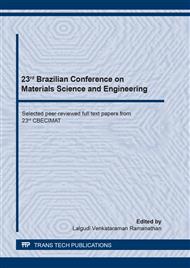p.461
p.466
p.471
p.477
p.483
p.489
p.494
p.500
p.506
Study of the Feasibility of Biodiesel Production, from Vegetable Oils and Catalysts of Seafood Residues, in a Batch Hydrogenation Reaction Unit, Assisted by Microwave and Conventional Heating
Abstract:
In this work, it was proposed to study the feasibility of biodiesel production, from residues of vegetable oils used in domestic activities, employing (CaCO3) shells prepared like calcium oxide (CaO) as catalysts, in a batch reaction unit, on bench scale, installed at IPEN-CNEN/SP. This unit is capable of operating with high pressure hydrogen gas (up to 200bar) and high temperature (up to 500°C, using microwave - MW (2.450MHz, with up to 2kW continuous and 8kW pulsed) and conventional heating – (electric) MC. In the tests, the oil load (mL), type and mass of catalyst, with or without hydrogen gas pressure (bar), temperature (°C), reaction time (h), microwave power (W), the speed of the load (rpm) agitation and the conventional heating were evaluated. The analytical determinations of the samples were carried out by means of density, gas chromatography (GC) and X-ray fluorescence. Data were collected in order to be compared with other methodologies, already used in the literature. The purpose of this work was to analyze the efficiency of the use of these types of catalysts and oils in the production of biodiesel, as an alternative technology. The Ca and CaO contents found in the pink shell, before and after the calcination, were 36.2% and 98.8%, respectively. The best result obtained for the density was 0.875182g/cm3, for the test with 4g of calcined shell catalyst and reaction of 1h. As to the methyl ester content, the highest result was 95.33%, in a test with 4g of catalyst and reaction of 3h. In the non-calcined shell test (22.5g), although the amount of mass used was much larger (5% of the oil mass), the ester content was very low, 2.11%.
Info:
Periodical:
Pages:
483-488
Citation:
Online since:
October 2020
Authors:
Price:
Сopyright:
© 2020 Trans Tech Publications Ltd. All Rights Reserved
Share:
Citation:



